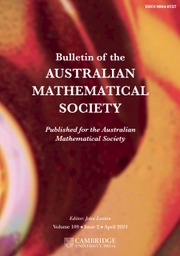No CrossRef data available.
Article contents
Finite p-groups with normal normalisers
Published online by Cambridge University Press: 17 April 2009
Extract
Core share and HTML view are not available for this content. However, as you have access to this content, a full PDF is available via the ‘Save PDF’ action button.
We consider the class N of groups in which the normaliser of every subgroup is normal, and the class C of groups in which the commutator subgroup normalises every subgroup. It is clear that C ⊆ N, and it is known that groups in the class N are nilpotent of class at most 3. We show that every finite p-group in N is also in C, provided that p ≥ 5, and we give an example showing that this is not true for p = 2.
- Type
- Research Article
- Information
- Bulletin of the Australian Mathematical Society , Volume 69 , Issue 1 , February 2004 , pp. 141 - 150
- Copyright
- Copyright © Australian Mathematical Society 2004
References
[1] Bryce, R.A. and Cossey, J., ‘A note on groups with Hamiltonian quotients’, Rend. Sem. Mat. Univ. Padova 100 1998, 1–11.Google Scholar
[2] Hobby, C., ‘Finite groups with normal normalizers’, Canad. J. Math. 20 1968, 1256–1260.CrossRefGoogle Scholar
[3] Heineken, H., ‘A class of three-Engel groups’, J. Algebra 17 1971, 341–345.CrossRefGoogle Scholar
[4] Huppert, B., Endliche Gruppen I (Springer-Verlag, Berlin, Heidelberg, New York, 1967).CrossRefGoogle Scholar
[5] Mahdavianary, S.K., ‘A special class of three-Engel groups’, Arch. Math. (Basel) 40 1983, 193–199.CrossRefGoogle Scholar
[6] Mahdavianary, S.K., ‘A classification of 2-generator p-groups, p ≥ 3, with many subgroup 2-subnormal’, Arch. Math. (Basel) 43 1984, 97–107.CrossRefGoogle Scholar
[7] Parmeggiani, G., ‘On finite p-groups of odd order with many subgroups 2-subnormal’, Comm. Algebra 24 1996, 2707–2719.CrossRefGoogle Scholar


